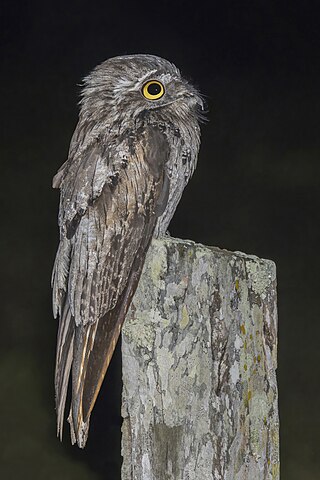
Potoos are a group of birds related to the nightjars and frogmouths. They are sometimes called poor-me-ones, after their haunting calls. The family Nyctibiidae was formerly included with the nightjars in the order Caprimulgiformes but is now placed in a separate order, Nyctibiiformes. There are seven species in two genera in tropical Central and South America. Fossil evidence indicates that they also inhabited Europe during the Paleogene.

The short-billed dowitcher, like its congener the long-billed dowitcher, is a medium-sized, stocky, long-billed shorebird in the family Scolopacidae.

The black wheatear is a wheatear, a small passerine bird in the Old World flycatcher family Muscicapidae. It is found in the Iberian Peninsula and western North Africa.
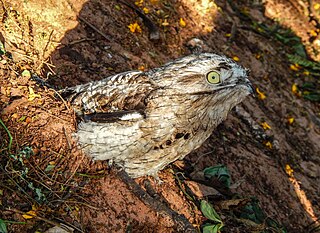
The common potoo, or poor-me-ones, or urutau is one of seven species of birds within the genus Nyctibius. It is notable for its large, yellow eyes and a wide mouth. Potoos are nocturnal and are related to nightjars and frogmouths. They lack the characteristic bristles around the mouths of true nightjars.
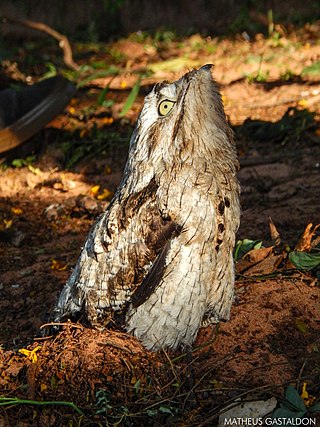
Nyctibius is a genus of potoos, nocturnal birds in the family Nyctibiidae.

The pauraque – also called the common pauraque to distinguish it from similar species – is a nightjar species, one of two birds in the genus Nyctidromus. It breeds in the subtropical and tropical regions of the New World, and except for northernmost birds it is largely resident all year round.
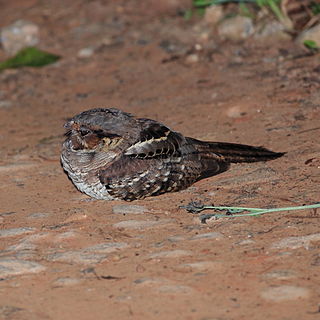
Nyctidromus is a genus of nightjars in the family Caprimulgidae. The species are widely distributed in Central and South America.

The plumbeous kite is a bird of prey in the family Accipitridae that is resident in much of northern South America. It is migratory in the northern part of its range which extends north to Mexico. It feeds on insects which it catches either from a perch or while in flight.
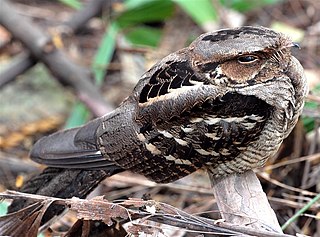
Caprimulgus is a large and very widespread genus of nightjars, medium-sized nocturnal birds with long pointed wings, short legs and short bills. Caprimulgus is derived from the Latin capra, "nanny goat", and mulgere, "to milk", referring to an old myth that nightjars suck milk from goats. The common name "nightjar", first recorded in 1630, refers to the nocturnal habits of the bird, the second part of the name deriving from the distinctive churring song.

The chuck-will's-widow is a nocturnal bird of the nightjar family Caprimulgidae. It is mostly found in the southeastern United States near swamps, rocky uplands, and pine woods. It migrates to the West Indies, Central America, and northwestern South America.

The great potoo or grand potoo is the largest potoo species and is widely distributed in Central and South America.

The marbled wood quail, also known as the Amazonian wood quail, is a species of bird in the New World quail family. It has an extensive distribution in Central America and the northern part of South America. Its natural habitat is subtropical or tropical moist lowland forests.
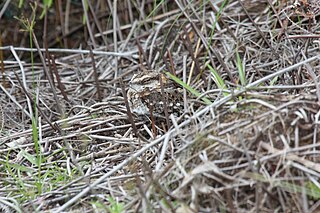
The white-tailed nightjar is a species of nightjar in the family Caprimulgidae. It is found in the tropic regions of Central and South America.

Hydropsalis is a genus of nightjars in the family Caprimulgidae. The species are widely distributed across the tropical and subtropical regions of the New World.

The scissor-tailed nightjar is a species of nightjar in the family Caprimulgidae. It is distributed over much of eastern South America.

The short-tailed nighthawk is a species of nightjar in the family Caprimulgidae. It is found in Mexico, in every Central American country except El Salvador, in Trinidad and Tobago, and in every mainland South American country except Chile and Uruguay.

The Andean potoo is a species of bird in the family Nyctibiidae. It is found in Bolivia, Colombia, Ecuador, Peru, and Venezuela.
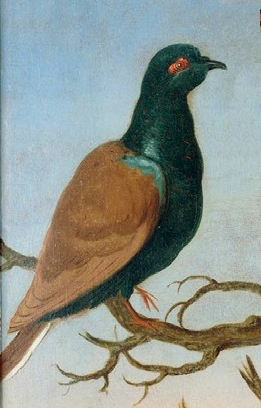
The São Tomé green pigeon is a species of bird in the family Columbidae. It is endemic to the island of São Tomé in São Tomé and Príncipe. Its natural habitat is subtropical or tropical moist lowland forests. The species was described by Johann Friedrich Gmelin in 1789. They have disappeared from Ilhéu das Rolas due to habitat loss. There are between 37,007-109,255 pigeons of this species today, but this is decreasing due to unsustainable levels of hunting.

The Greater Antillean bullfinch is a species of bird in the family Thraupidae.

The white-eyed thrush is a species of bird in the family Turdidae that is endemic to Jamaica. Its natural habitats are subtropical or tropical moist lowland forests, subtropical or tropical moist montane forests, and heavily degraded former forest.























